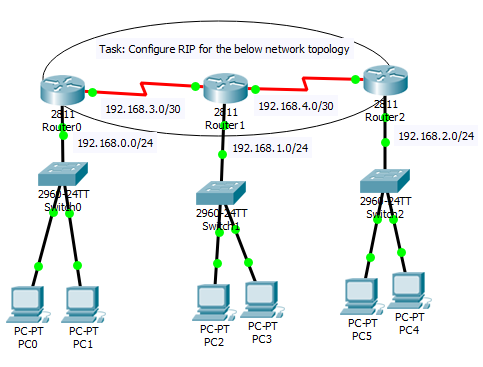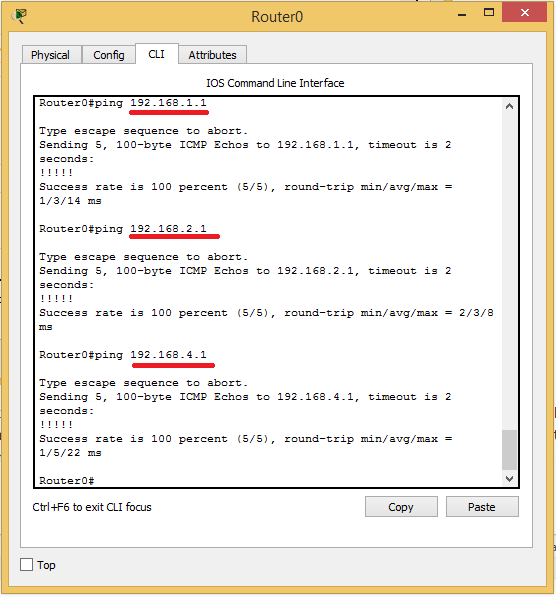The routing information protocol is an industry-standard distance vector routing protocol available to all vendors. It is one of the most popular dynamic routing protocols, howbeit, its limitations. In this Lab, I will share with us on how to implement RIP on Packet Tracer for a network topology with three Cisco routers.
Before I proceed to the configuration proper for this lab, Let’s look at a few things about RIP worth committing to memory.
- RIP is a distance vector routing protocol
- It has a default administrative distance of 120
- RIP can go a maximum hop of 15
- It uses hop counts to determine the shortest part to a remote network
- RIP has no support for classless addressing and variable length subnetmask (VLSM). RIPv2 does.
Network Topology

How to configure RIP on Packet Tracer for a network topology of three routers
The imlementation of this lab involves entering the below codes on all three routers, starting from Router0.
You may also like: how to implement eigrp on a network topology with three Cisco routers
Router0
Router>en
Router#conf t
Router(config)#hostname Router0
Router0(config)#int s0/3/0
Router0(config-if)#ip add 192.168.3.1 255.255.255.252
Router0(config-if)#no shut
Router0(config-if)#desc connection to Router1
Router0(config-if)#int f0/0
Router0(config-if)#ip add 192.168.0.1 255.255.255.0
Router0(config-if)#no shut
Router0(config-if)#desc connection to LAN
Router0(config-if)#exit
Router0(config)#router RIP
Router0(config-router)#netw 192.168.0.0
Router0(config-router)#netw 192.168.3.0
Router0(config-router)#no auto
Router0(config-router)#exit
Router0(config)#exit
Router0#copy run start
You may also like: OSPF implementation on a network topology of three cisco routers
Router1
Router>en
Router#conf t
Router(config)#hostname Router1
Router1(config)#int s0/3/0
Router1(config-if)#clock rate 64000
Router1(config-if)#ip add 192.168.3.2 255.255.255.252
Router1(config-if)#no shut
Router1(config-if)#desc connection to Router0
Router1(config-if)#int s0/2/0
Router1(config-if)#clock rate 64000
Router1(config-if)#ip add 192.168.4.1 255.255.255.252
Router1(config-if)#no shut
Router1(config-if)#desc connection to Router2
Router1(config-if)#int f0/0
Router1(config-if)#ip add 192.168.1.1 255.255.255.0
Router1(config-if)#no shut
Router1(config-if)#desc connection to LAN
Router1(config-if)#exit
Router1(config)#router RIP
Router1(config-router)#netw 192.168.1.0
Router1(config-router)#netw 192.168.3.0
Router1(config-router)#netw 192.168.4.0
Router1(config-router)#no auto
Router1(config-router)#exit
Router1(config)#exit
Router1#copy run start
Router2
Router>en
Router#conf t
Router(config)#hostname Router0
Router2(config)#int s0/3/0
Router2(config-if)#ip add 192.168.4.2 255.255.255.252
Router2(config-if)#no shut
Router2(config-if)#desc connection to Router1
Router2(config-if)#int f0/0
Router2(config-if)#ip add 192.168.2.1 255.255.255.0
Router2(config-if)#no shut
Router2(config-if)#desc connection to LAN
Router2(config-if)#exit
Router2(config)#router RIP
Router2(config-router)#netw 192.168.4.0
Router2(config-router)#netw 192.168.2.0
Router2(config-router)#no auto
Router2(config-router)#exit
Router2(config)#exit
Router2#copy run start
Verification
To verify the working of the lab, we need to confirm that we are learning all routes via RIP. To do this, we need to use #show ip route command. See results from Router0:

From Router0, we can see that networks 192.168.1.0/24, 192.168.2.0/24, and 192.168.4.0/24 are all being learned via RIP with default administrative distance of 120 and the hop count for network 192.168.2.0/24 recorded as 2. This is because network 192.168.2.0/24 is two routers away from Router0. Let’s run a ping test to those networks and see if it will be successful. See output below:

That’s it guys. to get the Packet Tracer file for this lab, kindly subscribe to this blog and it will be sent to your email address. To read more on Cisco RIP implementation, see Cisco official RIP documentation.

Kindly send me please the configurations for site to site using VPN and ipsec
Thank you for sharing this. This is the best way to configure the router and configure routing protocol. Easy to understand and easy to configure.
Here are my LABs, need your assistance, please check once.
Please send me the Packet Tracer file, I have subscribed !!
Apologies, file the requested file is no longer available.